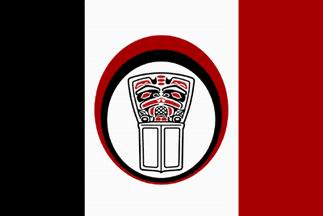Hobiyee facts for kids
Quick facts for kids Hobiyee |
|
|---|---|

Flag of the Nisg̱aʼa Nation
|
|
| Also called | Hoobiyee, Hobiyee, Hobiiyee, Hoobiiyee Like a Spoon |
| Observed by | Nisg̱aʼa |
| Significance | New Year |
| Date | February / March Buxw-laḵs / X̱saak |
Hobiyee (pronounced Ho-bee-YEE) is the exciting New Year celebration for the Nisg̱aʼa people. It happens every February or March. This special time marks the appearance of the first crescent moon. It also signals the start of the month called Buxw-laḵs. Nisg̱aʼa people celebrate Hobiyee wherever they live. The biggest parties are in their home territory, Nisg̱aʼa, and in places like Vancouver where many Nisg̱aʼa live.
Contents
What Does Hobiyee Mean?
The name Hobiyee comes from a Nisg̱aʼa phrase: "Hobixis hee!" This means "the moon is shaped like the hoobix." A hoobix is the bowl part of a traditional Nisg̱aʼa wooden spoon. So, Hobiyee is like saying "spoon moon!" It's a hopeful sign. If the crescent moon points upwards like a full spoon, it means there will be lots of food. It promises a year of good harvests.
Why is the Moon Important for Hobiyee?
Predicting the Year's Harvest
When the Hobiyee moon's edges point up, it's a great sign! It means there will be plenty of salmon, oolichans (a type of fish called saak), berries, and other foods. The months Buxw-laḵs and X̱saak mark the end of winter. They also signal the arrival of oolichans in the rivers. Oolichans were the first food to arrive when winter supplies were low. The word buxw means 'to blow about'. laḵs means 'needles'. x̱saak means 'to eat oolichans'.
Sometimes, people would look for a star in the middle of the crescent moon. This was another sign of a very good year. Different positions of stars around the moon had other meanings. If the Hobiyee moon was sideways and had no star, it meant a poor year for resources. This happened in 2006.
How is Hobiyee Celebrated?
Observing the Moon
In the past, Nisg̱aʼa chieftains, called simgigat, were in charge of managing resources. They also studied the stars and moon. Some leaders were very skilled at this. They could even predict the weather. These people were called guxw-hloḵsit, meaning astronomer or astrologist.
A spiritual leader, called a swan̓iskw, would carefully watch the moon in Buxw-laḵs. They would figure out when the harvest would begin in the Ḵ'alii-Aksim Lisims. Grandfathers would keep a close eye on the moon. When they saw the Hobiyee moon, they would run into the village. They would shout, "Hobiyee! Hobiyee!" Then, children would raise their arms. They would make the shape of the Hobiyee moon.
First Oolichan Ceremony
The Nisg̱aʼa people also had a special ceremony. It was for the first time they ate oolichans. This ceremony was called "Limx Wi’idim Saak". This means "song for roasting the first feed of oolichans." A special performer would wear ceremonial clothes. They would dance and sing while roasting the first oolichans over a fire.
The Nisg̱aʼa also have stories about the Simgigadim Saak, or Oolichan Chieftains. These stories are part of their traditions. There is also a story about how the oolichan and spring salmon teased each other. This happened as they passed each other in the Ḵ’alii-Aksim Lisims river. These stories show how much the Nisg̱aʼa believe in being connected to nature.
In 2017, Hobiyee was celebrated on February 14–15.

